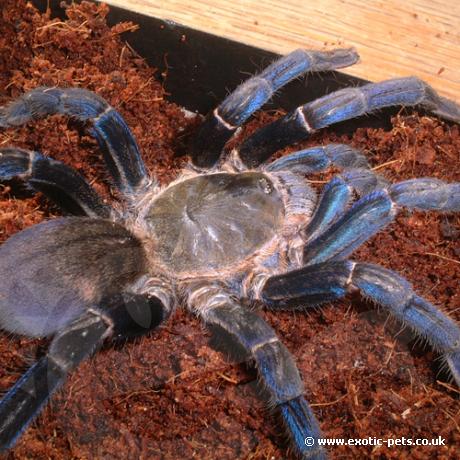

For the experienced tarantula keepers, this is a must for your collection. Although the Cobalt Blue Tarantula is aggressive and nervous, the adult colour makes it worth while.
This 2.5 inch bodied tarantula with a leg span of 4-5 inches has to be one of the most beautiful, yet aggressive species of tarantula. While spiderlings, their overall colour is a greyish blue. Adults on the other hand look dark brown-black at first glance. With the correct lighting you will see the legs have lovely blue sheen and the coxae is sliver. The males tend to be smaller and more brownish in colour. Immature specimens are less blue and the abdomen is lighter in colour.
Found in habitats on the edge of the forests floor in Burma, Malaysia, Singapore and Thailand.
Due to this species mainly borrowing, you should provide it with at least 4-6 inches of peat. They like a high humidity of 85-90%, so keep the peat moist, not soaking wet, spraying lightly a few times a day will help. The temperature needs to be in between 20-23C (68-73.4F), room temperature will be ideal.
Experience is needed, as they are fast and aggressive.
Being a Terrestrial species (ground living), you need to provide the Tarantula with more ground space than height. This species makes a network of burrows and lives inside them, only leaving its home during night. As stated above, the peat substrate must be deep and moist. Decor isn't really needed for this species, as they are underground pretty much all the time. You can place some moss on the surface of the peat, leaving small areas for the tarantula to dig.
Once a week, feed on a range of insects and depending on the age, the odd pinkie (baby mouse). Crickets can injury your tarantula during moulting, so any uneaten food should be removed if your tarantula doesn't seem interested, try feeding again a few days later. Always provide water, this can be via a shallow dish or Tarantula sponge!